SCADA – Do I Need It? (August 15, 2016)
“SCADA – Do I Need It?” is the next in a series of articles related to plunger lift provided by Shale Tec LLC (www.ShaleTec.com). Plunger lift is an economical artificial lift means to remove liquids from oil and gas wells. Shale Tec offers plunger lift training courses, workshops, consulting and well optimization coaching – yet does not manufacture or sell products.
The prior published articles include:
- Why Plunger Lift (Why is plunger lift needed?)
- When Plunger Lift (When is plunger lift needed?)
- Which Algorithm (Which algorithm is best?)
- Continuous Plunger Lift
This article takes a closer look at SCADA and why it’s invaluable for plunger lifted wells.
SCADA is an abbreviation for “Supervisory Control and Data Acquisition”. In essence, it’s the ability to view well site data and make changes to certain settings from a remote location. Some use the term telemetry, remote surveillance and even automation when referring to SCADA.
At the well site, a SCADA system requires a device or devices that provide data and a device that transmits and receives data. At the remote location (ie “office”), a device to receive and transmit data, polling software and human to machine interface (HMI) software is required. The polling software determines when to transmit / retrieve data and to / from which field devices. The HMI software displays the collected data in a manner easily understood by an operator. The displayed data can take the form of numerical entries, graphs and/or pictures of field devices with superimposed data depicted in the representative area of the image.
Gas flow rates are routinely conveyed by radios or modems from well sites to the “office”, thus providing an accurate and timely daily production update. In more elaborate systems, SCADA may be used to view real time gas flow rates, well pressures, tank volumes and various plunger lift data. SCADA also provides a method to change device settings (from a remote location), such as pressure transducer calibration, plunger lift controller settings, chemical pump injection rates, etc.
Prior to SCADA, all the data viewed at the office was first collected by a person at the well site– then entered into the proper forms or computer software at the office. Operators traveled to well locations each day to monitor status and initiate controller changes as needed. During the next day’s visit to the well, the operator might observe the positive effect of changes made the prior day. Conversely, if a negative affect occurred just as the operator left the well site, it would be at least 24 hours before the operator become aware of that result. This approach is often time consuming and frustrating, especially for new plunger lift installations. Operators might spend several weeks or more working with a single well just trying to get the plunger to cycle!
In addition to the imposed time constraints, well site only controllers (ie no SCADA) offer limited data to operators responsible for maximizing production. These controllers are generally limited to a 1 or possibly 2 line LED displays on the front panel of the controller. The operator scrolls through current vs historic pressures, flow rates and plunger arrival data, yet the display screen limitations restrict in depth analysis.
Using well site only controllers, plunger arrival data generally consist of the last 5 to 10 plunger arrivals and the time required for the plunger to travel from the bottom of the well to the surface (ie trip time). If the plunger rise velocity (well depth divided by trip time) is too fast or slow, the operator makes an adjustment to the controller settings. Viewing only trip time from a relatively few cycles offers insufficient data for the operator to make a good decision. Are the fast or slow arrivals caused by too much liquid or not enough lift pressure? Is the cause a temporary occurrence or long term trend?
Knowing to adjust casing pressure build time, afterflow time or even select a different plunger makes all the difference in optimizing plunger lifted wells.
Several years ago, one manufacturer operating in the Barnett Shale concluded significant hidden fees were associated with well site only plunger lift controllers (i.e. No SCADA). Once SCADA was implemented, the hidden fees were revealed and quantified. Those hidden fees included frequent venting of the well to surface the plunger, frequent plunger replacements and significant amounts of unplanned down time. In the chart below, the data reflects before and after telemetry was added to two plunger lifted wells.
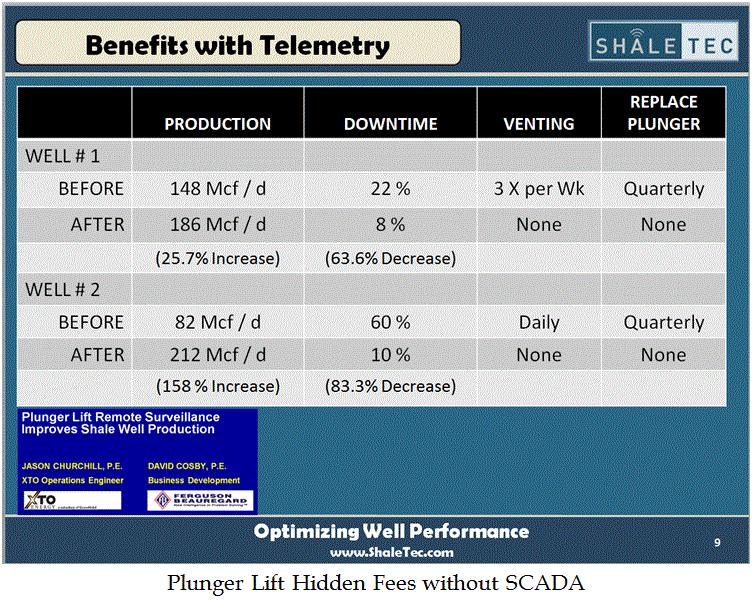
Operators have long recognized the benefits of plunger lift, yet when SCADA is added, additional benefits emerge! Plunger lift benefits documented by the industry are shown on the left side of the chart below, with additional benefits obtained through SCADA depicted on the right. One of the most significant SCADA benefits is the ability of an operator to remotely optimize many wells. By doing so, the operator quickly becomes an experienced plunger lift optimizer. Comparatively, an operator driving a typical route consisting of 40 to 60 wells a day, in which only a relatively few are plunger lift, experiences significant time barriers to rapidly obtaining the same skill level. On-site well observation will always be required, yet optimizing and troubleshooting plunger lifted wells is often more efficient when tackled by a highly skilled optimizer utilizing a proficient SCADA system.
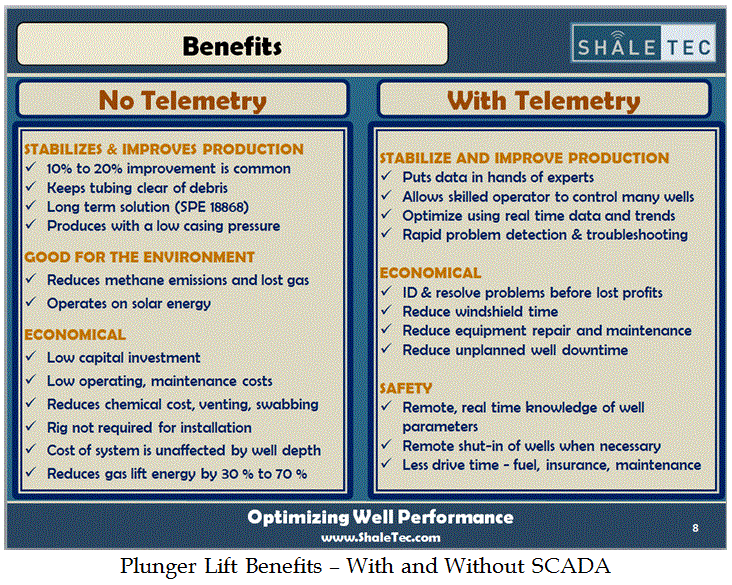
A typical plunger lift well site may look similar to the below illustration. In this configuration, it’s desirable to link all sensors and controllers to a single “box” that collects and transmits data to a remote location. That “box” may be the plunger lift controller, an electronic flow meter or a specialty box housing a modem or radio. The sensors and controllers may be linked through cable buried in liquid tight conduit or short range spread spectrum radios. Short range spread spectrum radios transmit and received at 900 MHz or 2.4 GHz, with the latter currently having less traffic at many locations, thus generating greater reliability.
Once the well site data is collected in a single “box” at the well site, it can be transmitted off site using cell phone data modems, FCC licensed radios, license free spread spectrum radios, satellites or a combination of the above. By combining technologies, a cell phone modem might send the data to a spread spectrum radio network – which then transmits the data through a serious of radios on towers to a base location.
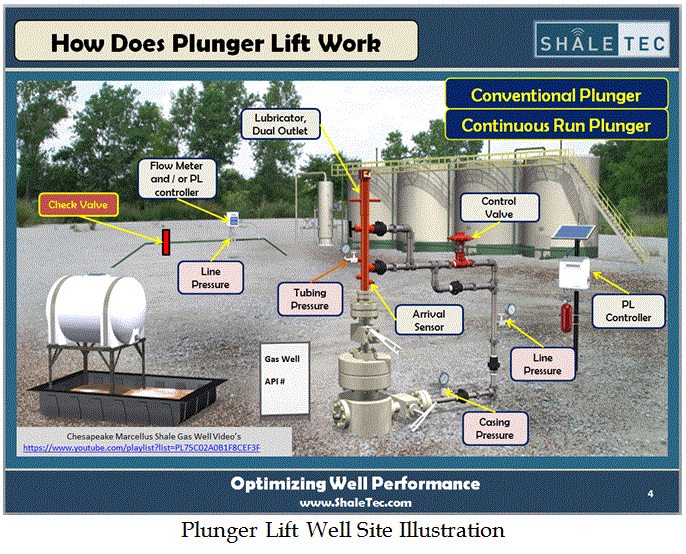
Once the data reaches the base location, it’s populated into software that presents the data to an optimizer in a usable format. That format and the actual data presented is as important as simply having access to the data!
Numerous suppliers offer plunger lift SCADA systems, including:
- SCADAdvantage by ABB
- Production Manager by Vinson Process Controls
- Cygnet by Weatherford
- SCADAVISOR by Fielding Systems (Quorum Systems)
- ClearSCADA and Wonderware by Schneider Electric
- Plunger Lift Manager by PCSFerguson
- SCADALynx by eLynx Technologies
These suppliers display data on screens in a variety of formats. The data may be presented as text, graphs or even pictures of well site devices. The data presented should be intuitive to understand and readily promote good well optimization decisions.
Some SCADA systems offer great flexibility, allowing data to be collected and presented in a seemingly infinite number of variations. Internal IT experts may be required to limit the data displayed, and format it a manner most valuable to well optimizers. Regardless of the SCADA system selected, operators typically need access to the following in order to make good decisions effecting well performance:
- Well summary screen
- Daily production plotted from IP to current with a decline curve
- Key plunger data for each well (ie Plunger status)
- Trend data – flow rate and pressures over time (see below)
- Cycle history – open and close conditions on every cycle (see below)
- Controller set-up and settings adjustments
- Well notes linked to trend graph
- Preventative maintenance schedule
- Plunger cycle diagnostics
Trend data is a plot of plunger lift pressures and flow rates over time. By carefully observing variations to a normal plunger cycle, optimizers adjust settings to maximize production and resolve problems before production is lost!
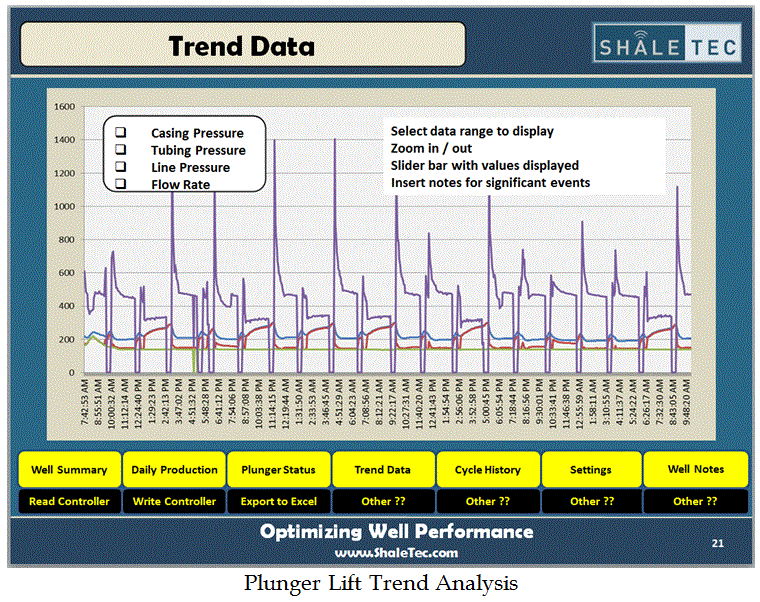
Recording plunger cycle data on every plunger run is often overlooked, yet valuable in optimizing and troubleshooting wells. The chart below shows one effective format for displaying critical plunger cycle history data.
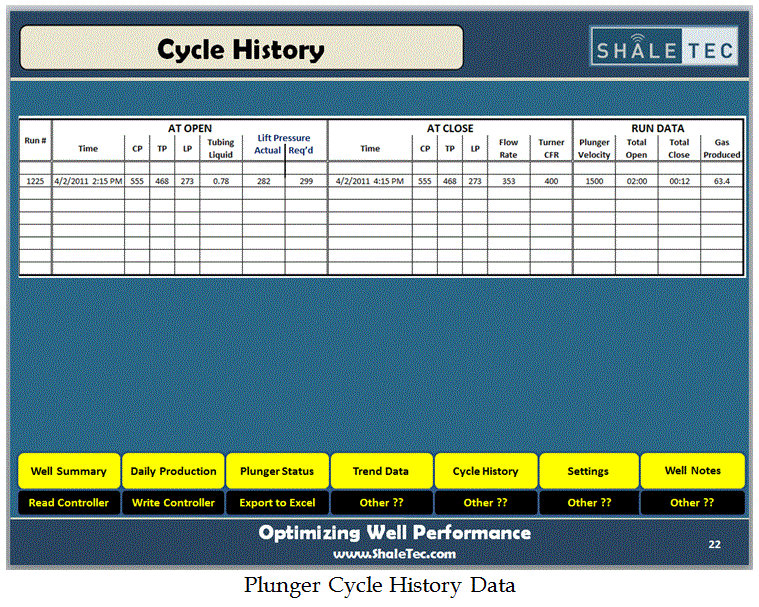
In conclusion, SCADA offers significant and profitable benefits to operators with plunger lifted wells. With SCADA, a skilled operator may optimize many wells a day without the lengthy delay incurred by driving to each site each day. SCADA provides real time, detailed knowledge of well conditions in an actionable format, promoting good decisions by the optimizer. And, SCADA enables real time troubleshooting and corrective action of identified problems before production is lost.
If you operate plunger lifted wells – YES, you need SCADA!
If your team could benefit from a deeper understanding of plunger lift, contact Shale Tec LLC (www.ShaleTec.com) to schedule a 2-Day Plunger Lift Training Course, 1-Day Workshop – or come join us at one of these open registration courses!
- Houston, Texas August 30, 31
- Hobbs, New Mexico September 19, 20
- Farmington, New Mexico September 22, 23
And, consider joining the Linkedin Group “Plunger Lifted Gas Wells”!
The above article was written by David Cosby P.E. of Shale Tec LLC
Copyrighted August 2016